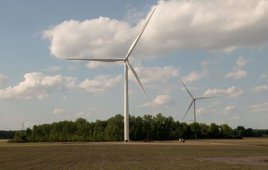Tom Wang, President, GammaTech Computer Corp.
If you like working outdoors in wide-open spaces where the wind blows strong, a career as a wind technician may be for you. It’s probably no surprise that a lot of maintenance work starts by receiving electronic work orders from an O&M manager and finishes by submitting repair reports, all wirelessly. But working in remote and sometimes hostile conditions presents unique challenges. It makes make computers or tablets common to office settings (regardless of brand name) almost useless in the middle of a wind farm, on land or at sea.
The problem with office computers

When it comes to selecting a computer for wind-power field applications, the choice is clearly a rugged notebook or tablet.
Most wind-power companies deploy large mobile workforces over huge areas. Using commercially available office computers in these situations is highly impractical for several reasons. For instance, such devices tend to have short life spans. Supporting multiple generations of products in the field adds yet another level of complexity. A large number of technicians working remotely also means bringing the team together at a central location for frequent and costly training sessions regarding new technology.
Just transporting or using a computer device in a vehicle presents challenges not normally encountered in office settings. Inside a vehicle, it is typically hot or cold, humid, dirty, and prone to coffee-spills. What’s more, a non-secured computing device inside a vehicle can become a projectile in an accident, causing potential harm to any passenger. In addition, commercial computers screens are difficult to see in direct or indirect sunlight, making wind-power technicians’ jobs more difficult to complete, if they were to use them.
Lastly, don’t forget the countless bumps, ruts, rocks, mud holes, and other objects generously referred to as road hazards that are encountered at almost all land-based wind farms. And while pot holes are not a problem traveling to offshore sites, waves, winds, and salt spray can wreak havoc on electronic devices. The only viable solution is a rugged notebook or tablet.
Why ruggedized computers
It is critical that notebooks and tablets used in the wind-power sector are classified as rugged, durable, and reliable to be completely useful in remote and challenging work environments. Having a rugged computer on the job, away from an office setting, gives technicians and other wind-power field workers access to necessary documents, files, the company network, and the Internet – no matter where the wind takes them. Rugged computing devices result in increased productivity and efficiency.

Rugged computers typically offer safe and secure mounting solutions that allow for effective deployment of airbags, additional power to the device, and external antennas for improved data coverage.
Such computers are designed for non-traditional work environments. Whether in the field or inside a vehicle, viewing the computer screen in direct – and even filtered – sunlight is imperative for workers to accurately collect and input data. Rugged computers are built to handle these environments, along with high humidity and salt spray common to offshore sites.
Furthermore, rugged computers have longer life cycles that accommodate complex installations, simplifying the already complex topic of field support.
In addition, the total cost of ownership over a product’s life has been studied and documented proving that the rugged computers cost less than that for traditional commercial computers. Downtime, repairs, and superior data coverage are a few key factors that justify the total cost of using rugged computing devices in hostile wind-farm environments.
For a computer not designed tough from the outset, disaster is waiting when it is used in harsh elements such as those incurred by wind-power technicians. Rugged computers can work in all sorts of wicked conditions, where such commercial devices would never stand a chance of succeeding – or computing.
A candidate for wind duty
The line of rugged mobile computers, called DURABOOK, are designed and manufactured to not just survive, but work well in the harshest environments. The unpredictable mobile and field environment exposes equipment to high and low temperatures, beverage spills, drops, and vehicle dust to name a few. Every component in the computer is selected and installed to handle the freezing temperatures of the Northeast to the hot summers of the Southwest. Each unit is vigorously tested to meet MIL STDs related to vibration, shock, and drops to ensure the display will not crack, shatter, or “flop” and the components will remain intact providing maximum reliability over the life of the computer. The keyboards and I/O ports are sealed to prevent liquid or dust intrusion, which can affect reliability over time. A readable display is one of the biggest challenges and the DURABOOK computers have screens engineered to be readable outside a controlled office environment.
Filed Under: Uncategorized




